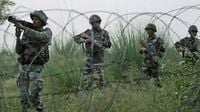In a dramatic escalation of tensions along the Line of Control (LoC), Pakistan has violated the ceasefire agreement by firing artillery in Bhimber Gali, located in the Poonch-Rajauri area of Jammu and Kashmir. This violation occurred just hours after India launched Operation Sindoor, a series of precision strikes targeting nine terrorist camps in Pakistan and Pakistan-occupied Jammu and Kashmir (PoJK) on May 7, 2025.
The Indian Army confirmed the artillery fire from across the border, stating, "Pakistan again violates the Ceasefire Agreement by firing artillery in Bhimber Gali in Poonch-Rajauri area. Indian Army is responding appropriately in a calibrated manner," in a post on X (formerly Twitter). This latest incident comes in the wake of a brutal terrorist attack in Pahalgam that resulted in the deaths of 25 Indian civilians and one Nepali national, prompting India to take decisive military action.
Operation Sindoor was officially launched in a pre-dawn offensive, with the Ministry of Defence releasing a statement at 1:44 AM confirming the strikes. The operation aimed to dismantle terrorist infrastructure in Pakistan and PoJK, specifically targeting locations believed to be planning and directing attacks against India. An official statement from the Ministry of Defence declared, "A little while ago, the Indian Armed Forces launched 'OPERATION SINDOOR', hitting terrorist infrastructure in Pakistan and Pakistan-occupied Jammu and Kashmir from where terrorist attacks against India have been planned and directed."
The operation focused on nine carefully selected sites, including Muzaffarabad and Kotli in PoK, as well as Bahawalpur in Pakistan’s Punjab province. These areas have been flagged for their links to militant activities. Muzaffarabad serves as the administrative capital of PoK, while Kotli is noted for its proximity to infiltration routes. Bahawalpur has been associated with the Jaish-e-Mohammed terrorist group, known for its training camps.
Pakistan's military spokesperson confirmed that five locations were struck, including Muridke, reporting at least three casualties and twelve injuries in the initial damage assessment. This counteraction by Pakistan has further heightened tensions in the region, with heavy mortar shelling reported from various forward villages along the LoC, including Krishna Ghati, Shahpur, and Mankote in Poonch, and Laam, Manjakote, and Gambeer Brahmana in Rajouri district.
Indian forces responded to the shelling, leading to ongoing exchanges of fire across the border. The situation remains tense, with military officials monitoring developments closely. The Indian Army's response has been characterized as appropriate and calibrated, reflecting a commitment to maintaining operational restraint while addressing security threats.
In the aftermath of the Pahalgam attack, which was described as barbaric, Indian officials reiterated their resolve to hold those responsible accountable. The Minister of Defence emphasized that the operation was “focused, measured, and non-escalatory” in nature, underscoring that no Pakistani military installations were targeted during the strikes. This approach highlights India's strategy of exercising restraint in the face of provocation.
As the dust settles on this latest round of conflict, the Indian government has indicated that further briefings regarding Operation Sindoor will be provided later in the day. This will likely include detailed assessments of the operation's outcomes and the implications for future military engagements.
The situation on the ground remains fluid, with reports of a powerful explosion heard in the Panthiyal sub-division of Ramban district, though its cause has yet to be determined. As both nations navigate this precarious moment, the international community watches closely, aware that any missteps could lead to wider conflict.
In conclusion, the recent military actions underscore the persistent volatility in the region, driven by a cycle of violence and retaliation. As both sides prepare for potential escalations, the hope for a diplomatic resolution seems increasingly distant.





